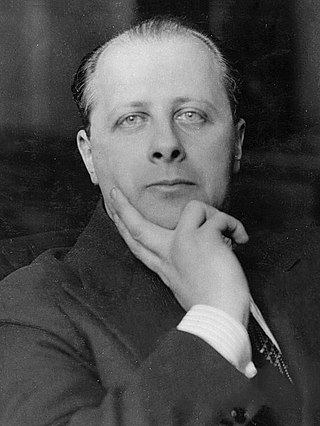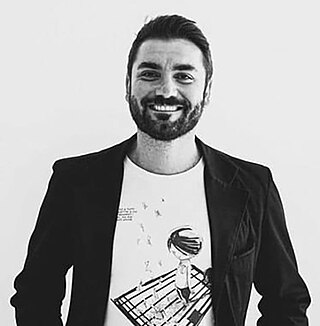
Ferruccio Parri was an Italian partisan and anti-fascist politician who served as the 29th Prime Minister of Italy, and the first to be appointed after the end of World War II. During the war he was also known by his nom de guerreMaurizio.
The Action Party was a liberal-socialist political party in Italy. The party was anti-fascist and republican. Its prominent leaders were Carlo Rosselli, Ferruccio Parri, Emilio Lussu and Ugo La Malfa. Other prominent members included Leone Ginzburg, Ernesto de Martino, Norberto Bobbio, Riccardo Lombardi, Vittorio Foa and the Nobel-winning poet Eugenio Montale.

Giustizia e Libertà was an Italian anti-fascist resistance movement, active from 1929 to 1945. The movement was cofounded by Carlo Rosselli, Ferruccio Parri, who later became Prime Minister of Italy, and Sandro Pertini, who became President of Italy, were among the movement's leaders.

Carlo Alberto Rosselli was an Italian political leader, journalist, historian, philosopher and anti-fascist activist, first in Italy and then abroad. He developed a theory of reformist, non-Marxist socialism inspired by the British Labour movement that he described as "liberal socialism". Rosselli founded the anti-fascist militant movement Giustizia e Libertà. Rosselli personally took part in combat in the Spanish Civil War, where he served on the Republican side.

Concentrazione Antifascista Italiana, officially known as Concentrazione d'Azione Antifascista, was an Italian coalition of anti-fascist groups which existed from 1927 to 1934. It was formed in Paris on 27 March 1927 with the purpose of the organization of Italian antifascist forces in order to reorganize the anti-fascist movement abroad avoiding to repeat the old divisions existing in Italy before the establishment of the regime. The CAI made a public appeal signed by Claudio Treves and Giuseppe Emanuele Modigliani (PSLI), Pietro Nenni and Angelica Balabanoff (PSI), Fernando Schiavetti and Mario Pistocchi, Bruno Buozzi and Felice Quaglino (CGdL) and by Alceste De Ambris. Communists remained outside along with liberals, populars and others in order to keep contact with Italian masses «in their social defence and political resistance moves». The official weekly newspaper La Libertà was created on 1 May 1927 with Claudio Treves as director.

Claudio Treves was an Italian politician and journalist.

Il Mondo was an Italian afternoon political newspaper with headquarters in Rome. Founded in 1922, it was one of the last independent newspapers to be suppressed by the Fascist Regime in October 1926.

L'Asino was an Italian magazine of political satire founded in Rome in 1892, by Guido Podrecca (1865–1923) and Gabriele Galantara (1867–1937), a former mathematics student, designer and cartoonist, both with a socialist background. The two took the pseudonyms "Goliardo" (Podrecca) and "Ratalanga" (Galantara), and with these nicknames signed the outputs of the weekly. The magazine's title was from a saying of Francesco Domenico Guerrazzi that said that "the donkey is like the people: useful, patient and stubborn", which became the subtitle and the motto of the editors.
The Mazzini Society was an antifascist political association, formed on a democratic and republican basis, situating itself within the tradition of the Risorgimento, and created in the United States by Italian-American immigrants in the late 1930s. It was named after Giuseppe Mazzini, a leading figure of Italian reunification in the mid-19th century, who had worked from exile.
Alberto Tarchiani was an Italian journalist, politician, and diplomat.

Marc'Aurelio was an Italian satirical magazine, published between 1931 and 1958, and briefly resurrected in 1973.

Guido Ceronetti was an Italian poet, philosopher, novelist, translator, journalist and playwright. He was born in Turin, Italy.
The Italian partisan brigades were armed formations involved in the Italian resistance during the World War II.
The Women's Defence Groups were a multi-party organisation of women active during the Italian Resistance. The groups were formed in Milan in November 1943 as part of an initiative by the Italian Communist Party.

Stefano Siglienti was an Italian banker and politician who served as the minister of finance from 18 June until 12 December 1944. He held several banking posts until his death.

Alberto Cianca (1884–1966) was an Italian journalist and anti-fascist politician. He edited several significant publications, including Il Mondo, and served in the Parliament and Senate.
Giustizia e Libertà, also known as Quaderni di Giustizia e Libertà, was an Italian anti-Fascist publication that was founded by the members of an anti-Fascist movement with the same name established in Paris. The magazine existed between May 1934 and May 1940. Its subtitle was Movimento unitario per l’autonomia operaia, la repubblica socialista, un nuovo umanesimo.

Lelio Bonaccorso, is an Italian comic artist and illustrator.
Carlo Francovich was an Italian politician, partisan and literary historian.
Paolo Spriano was an Italian historian of the Italian labor and communist movement.












